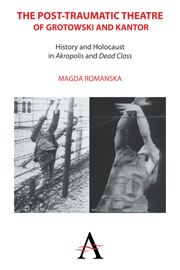 The Post-traumatic Theatre of Grotowski and Kantor
The Post-traumatic Theatre of Grotowski and Kantor from Part I - Our Auschwitz: Grotowski's Akropolis
During the first twenty years following World War II, in Poland, Auschwitz was a site of political and ideological manipulations, where numerous political interests intertwined, structuring and restructuring its meaning. In the early years, Auschwitz served as a symbol of national struggle, but also as a tool of Cold War propaganda, a site of antifascist/anticapitalist manifestations. It is here, for example, that the Polish government staged a demonstration against the Korean War to denounce the “imperialistic” policies of the USA. And in the 1950s, at one of the exhibits, pictures of Auschwitz prisoners were placed alongside photos of New York's homeless and caricatures of American soldiers. In 1955, following Stalin's death, nationalist sentiments resurfaced: a new exhibit was opened that again stressed the national, rather than the ethnic, identities of the Auschwitz victims. As a result of all the political propaganda, in the early 1960s Auschwitz became a principal destination of school groups and workplace trips, visited more often than Wawel. In homage to Borowski, in 1959 Tadeusz Rożewicz even wrote a short story, “Trip to the Museum” [Wycieczka do muzeum], attempting to capture the sheer horror and superficiality of those trips. Using Borowski's deadpan tone, Rożewicz coolly describes the stream of tourists wandering the Auschwitz site. In search of excitement, carelessly quoting sentimental cliches and propaganda slogans, they eagerly ask where they can see “the hair.”
To save this book to your Kindle, first ensure [email protected] is added to your Approved Personal Document E-mail List under your Personal Document Settings on the Manage Your Content and Devices page of your Amazon account. Then enter the ‘name’ part of your Kindle email address below. Find out more about saving to your Kindle.
Note you can select to save to either the @free.kindle.com or @kindle.com variations. ‘@free.kindle.com’ emails are free but can only be saved to your device when it is connected to wi-fi. ‘@kindle.com’ emails can be delivered even when you are not connected to wi-fi, but note that service fees apply.
Find out more about the Kindle Personal Document Service.
To save content items to your account, please confirm that you agree to abide by our usage policies. If this is the first time you use this feature, you will be asked to authorise Cambridge Core to connect with your account. Find out more about saving content to Dropbox.
To save content items to your account, please confirm that you agree to abide by our usage policies. If this is the first time you use this feature, you will be asked to authorise Cambridge Core to connect with your account. Find out more about saving content to Google Drive.